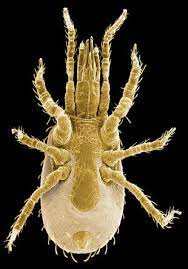Mesostigmata: Difference between revisions
No edit summary |
No edit summary |
||
| Line 24: | Line 24: | ||
== Characteristics == | == Characteristics == | ||
Mesostigmatic mites begin their life cycle as larvae that appear similar to prostigmatic or astigmatic mites, with a rounded body covered in small setae. Setae are small hairs that line the body of mesostigmata that serve numerous purposes. Setae are very sensitive, helping the mites detect changes in their surroundings, differentiating between water and land environments, and possibly chemosensory actions such as distinguishing food types.[3] | Mesostigmatic mites begin their life cycle as larvae that appear similar to prostigmatic or astigmatic mites, with a rounded body covered in small setae. Setae are small hairs that line the body of mesostigmata that serve numerous purposes. Setae are very sensitive, helping the mites detect changes in their surroundings, differentiating between water and land environments, and possibly chemosensory actions such as distinguishing food types.[3] During their life cycle, the mites | ||
[[File:Setae.jpg|thumb|Setae on the leg of a mesostigmatic mite [4].]] | [[File:Setae.jpg|thumb|Setae on the leg of a mesostigmatic mite [4].]] | ||
Revision as of 15:03, 17 May 2022
Mesostigmata are a suborder of mites which are primarily characterized by their large stigmas, which preform numerous functions for the mites as both a function of the respiratory system and to capture and kill their prey. Mesostigmatic mites are the most prominent of all Acari, comprising up to 25% of the total mite population. Due to the large size of thier stigma and other mouthparts, they can often be mistaken for their relative the tick.

Taxonomy
| Domain | Kingdom | Phylum | Class | Order | |
|---|---|---|---|---|---|
| Classification | Eukaroyta | Animalia | Arthropoda | Arachnida | Mesostigmata |
Characteristics
Mesostigmatic mites begin their life cycle as larvae that appear similar to prostigmatic or astigmatic mites, with a rounded body covered in small setae. Setae are small hairs that line the body of mesostigmata that serve numerous purposes. Setae are very sensitive, helping the mites detect changes in their surroundings, differentiating between water and land environments, and possibly chemosensory actions such as distinguishing food types.[3] During their life cycle, the mites

Impact on Soils

References
[1] “Mesostigmata (Monogynaspida) Introduction.” Mesostigmata (Monogynaspida) - Introduction, https://idtools.org/id/mites/invasive_mite/Invasive_Mite_Identification/key/Mesostigmata/Media/Html/100Introduction.htm.
[2] Life Cycle of D. Gallinae and Checkpoints for the Evaluation of Vaccine ... Research Gate, https://www.researchgate.net/figure/Life-cycle-of-D-gallinae-and-checkpoints-for-the-evaluation-of-vaccine-efficacy-The-SEM_fig1_335920316.
[3] and [4] “Seta.” Seta - an Overview | ScienceDirect Topics, https://www.sciencedirect.com/topics/agricultural-and-biological-sciences/seta.